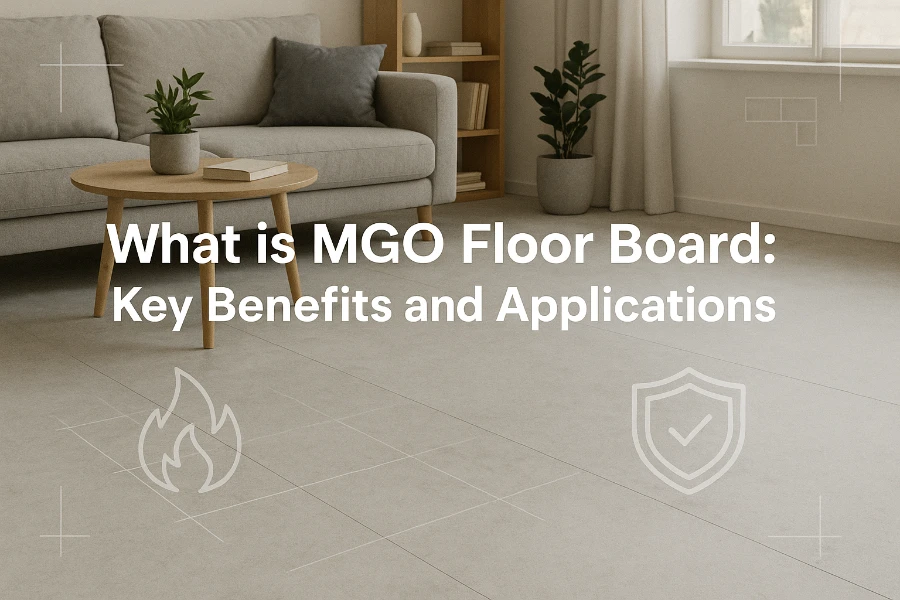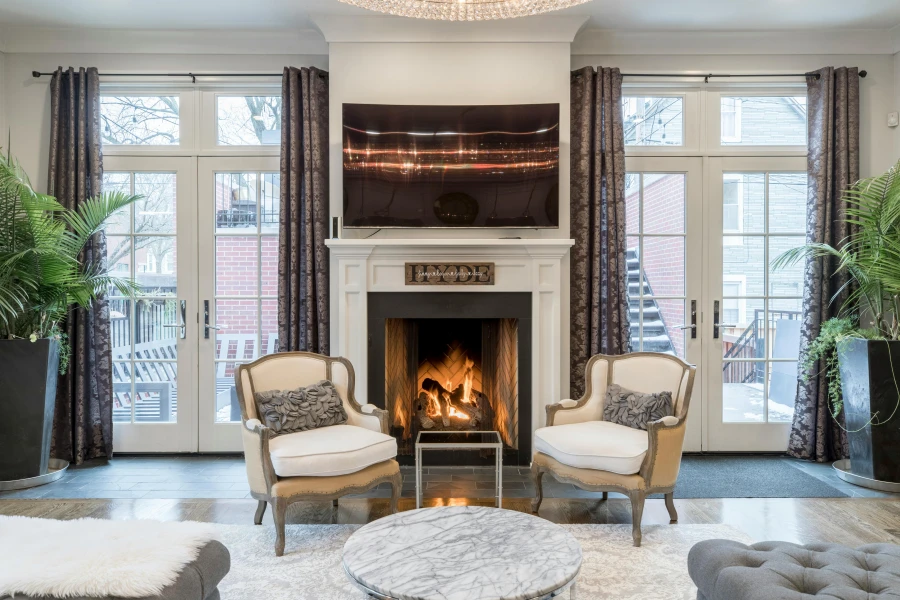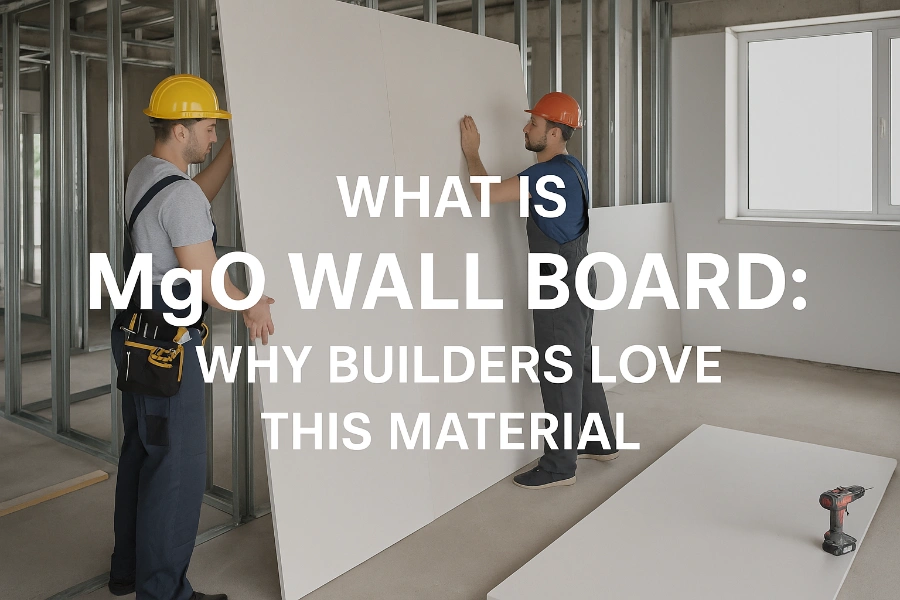Table of Contents
Ask Us Any Question
Why Flooring Material Matters
Choosing the right flooring material is a critical decision in any construction or renovation project. The floor not only supports the weight of people, furniture, and equipment but also contributes to the overall safety, durability, and comfort of a building. Traditional flooring materials such as plywood, oriented strand board (OSB), and cement boards have been widely used for decades, but they come with a variety of challenges. Plywood, for example, is prone to warping and swelling when exposed to moisture, while OSB boards may lack the required fire resistance and long-term durability. Cement boards, although stronger, are heavy, difficult to cut, and can require additional labor for installation.
In recent years, magnesium oxide (MgO) has emerged as a highly versatile alternative for flooring applications. MGO floor board, made from magnesium oxide and other natural additives, combines fire resistance, moisture resistance, structural strength, and environmental friendliness into a single, easy-to-install panel. This new-generation flooring material addresses many of the limitations associated with traditional boards while providing additional benefits such as eco-friendliness and compatibility with modern construction systems.
For architects, builders, and homeowners, understanding the advantages of MGO floor board is becoming increasingly important. With stricter building codes, rising concerns about indoor air quality, and the need for sustainable materials, MGO floor board offers a solution that meets both regulatory requirements and practical expectations. By exploring its composition, features, and applications, we can see why this material is rapidly gaining popularity in both residential and commercial projects.
What is MGO Floor Board?
MGO floor board is a type of engineered panel primarily composed of magnesium oxide (MgO), magnesium chloride (MgCl₂), and other natural fillers like perlite, fiberglass mesh, and wood pulp. Unlike standard MgO wall boards, which are primarily designed for vertical surfaces, MGO floor board is specifically engineered to withstand the structural loads and dynamic stresses associated with flooring. Its composition ensures both durability and safety, making it suitable for high-traffic areas and heavy-duty applications.
The manufacturing process begins with carefully blending magnesium oxide and magnesium chloride with fillers and reinforcing fibers. This mixture is then poured into molds and cured under controlled conditions to achieve uniform strength and density. Some high-end MGO floor boards undergo a secondary heat treatment to enhance fire resistance and dimensional stability. Quality control measures include checking moisture content, density, flexural strength, and thickness to ensure each panel meets international standards.
Thickness for MGO floor board typically ranges from 18mm to 20mm, depending on application requirements, while density generally falls between 1100kg/m³ and 1,200kg/m³. This combination of thickness and density ensures a stable, load-bearing floor that resists warping, cracking, and sagging over time.
In addition to its physical properties, MGO floor board is chemically stable and non-toxic. It does not emit volatile organic compounds (VOCs) and is free from asbestos or other hazardous materials commonly found in older flooring systems. This makes it not only a practical choice for builders but also a safer option for homeowners, particularly in residential spaces where indoor air quality is a priority.
Key Features of MGO Floor Board
High Fire Resistance
One of the most notable features of MGO floor board is its exceptional fire resistance. Unlike plywood or standard gypsum boards, which can ignite or degrade under high temperatures, MGO floor board is classified as non-combustible and can withstand temperatures above 1,000°C without structural failure. This makes it particularly suitable for public buildings, commercial spaces, and residential areas where fire safety is a primary concern.
The fire-resistant properties stem from the chemical composition of the board. Magnesium oxide, combined with reinforcing fibers and fillers, forms a dense, non-flammable structure that does not release toxic gases when exposed to heat. Many MGO floor boards meet international fire rating standards such as ASTM E119 and EN 13501, ensuring they provide reliable protection in both normal and emergency situations.
Compared with traditional flooring options, installing MGO floor board significantly reduces fire-related risks. In multi-story buildings or areas with high foot traffic, this characteristic can prevent the rapid spread of fire, giving occupants more time to evacuate safely and reducing property damage.
Moisture and Mold Resistance
Moisture resistance is another critical feature of MGO floor board. Unlike plywood or MDF, which can swell, warp, or become soft when exposed to water, MGO floor board is highly resistant to water absorption. This quality makes it ideal for humid environments such as kitchens, bathrooms, basements, or areas prone to flooding.
Tests show that water absorption rates for MGO floor board are typically below 10%, significantly lower than that of traditional wood-based materials. This not only preserves the board’s structural integrity over time but also prevents mold and mildew growth, which can compromise indoor air quality and pose health risks.
By resisting moisture, MGO floor board minimizes maintenance costs and reduces the likelihood of long-term repairs. Builders and homeowners benefit from a material that maintains stability and performance even in challenging environmental conditions.
Structural Strength and Stability
MGO floor board is engineered to provide exceptional compressive and flexural strength. These properties allow it to support heavy loads without bending or cracking, making it suitable for high-traffic areas in both residential and commercial buildings. Typical compressive strength ranges from 7 to 12 MPa, while flexural strength can exceed 6 MPa, depending on board thickness and reinforcement.
The stability of MGO floor board is further enhanced by its low shrinkage rate. Unlike concrete or gypsum boards, it maintains dimensional consistency over time, preventing gaps, uneven surfaces, or buckling. This structural reliability ensures that floors remain level and secure, even under repeated stress or dynamic loads from furniture, machinery, or foot traffic.
Dimensional Accuracy and Easy Installation
Precision in manufacturing allows MGO floor board to offer excellent dimensional accuracy. Panels are uniform in thickness and flatness, simplifying installation and reducing labor time. They can be easily cut with standard woodworking tools, drilled for screws, and finished with adhesives without the risk of crumbling or excessive dust.
MGO floor board is compatible with a variety of finishing layers, including vinyl, laminate, SPC (stone plastic composite), and tiles. This versatility enables builders and designers to meet aesthetic and functional requirements without compromising the floor’s performance. Additionally, its lightweight nature compared with cement boards makes handling and transportation easier, further streamlining the installation process.

Key Benefits of Using MGO Floor Board
Enhanced Safety in Fire-Prone Areas
Safety is a top priority for any building project, and MGO floor board excels in this regard due to its superior fire resistance. In environments where fire hazards are a concern—such as schools, hospitals, hotels, and public buildings—MGO floor board provides an additional layer of protection. Its non-combustible nature ensures that flames do not spread rapidly across the floor, reducing the risk of property damage and giving occupants more time to evacuate safely.
Moreover, unlike some conventional flooring materials that release toxic gases when burning, MGO floor board is chemically stable and does not emit harmful fumes. This makes it a safer choice for both occupants and emergency responders during fire incidents. Integrating MGO floor board into building design demonstrates a proactive approach to fire safety, aligning with modern construction standards and safety regulations.
Cost-Effective Over Time
Although the initial cost of MGO floor board may be slightly higher than traditional plywood or OSB boards, its long-term benefits make it a cost-effective investment. Its durability and resistance to fire, moisture, and mold minimize maintenance requirements and reduce the likelihood of costly repairs or replacements.
Over the lifespan of a building, the reduced frequency of maintenance, coupled with the board’s longevity, results in substantial savings. For commercial and residential projects alike, this cost-effectiveness is a compelling reason to choose MGO floor board. Its strength and stability also reduce structural risks, further preventing potential financial losses caused by damaged flooring.
Eco-Friendly and Non-Toxic
Sustainability is an increasingly important consideration in construction. MGO floor board is eco-friendly, as it is produced from natural, recyclable materials and does not contain harmful chemicals such as formaldehyde or asbestos. Additionally, it emits no volatile organic compounds (VOCs), contributing to healthier indoor air quality.
For environmentally conscious builders and homeowners, this aspect makes MGO floor board an attractive choice. Its manufacturing process consumes less energy compared with traditional cement or gypsum boards, and the use of natural mineral components reduces the overall carbon footprint of a building project. In addition, disposal and recycling of MGO floor board are more environmentally responsible, making it a material aligned with green building initiatives.
Compatibility with Modern Building Systems
Another key benefit of MGO floor board is its compatibility with modern construction systems. Its stable, flat panels work seamlessly with steel structures, raised flooring systems, and radiant floor heating installations. Unlike some traditional boards, MGO floor board can endure temperature fluctuations without warping or losing integrity, making it ideal for contemporary building designs that incorporate underfloor heating or modular construction techniques.
This versatility not only simplifies the design and installation process but also ensures that builders can meet a wide range of architectural requirements. Whether in residential, commercial, or industrial projects, the adaptability of MGO floor board enhances its overall value and appeal.
Applications of MGO Floor Board
Subflooring in Residential Buildings
MGO floor board is an ideal choice for residential subflooring due to its strength, stability, and resistance to moisture. In apartments, villas, and modular homes, it provides a flat, durable foundation for various types of finish flooring, including vinyl, laminate, SPC, and tiles. Its non-combustible nature also ensures enhanced safety for families, particularly in multi-story buildings where fire regulations are strictly enforced.
Because of its low water absorption rate, MGO floor board is particularly advantageous in areas prone to humidity, such as kitchens, bathrooms, and basements. It resists swelling and mold growth, ensuring a long-lasting and healthy living environment. Additionally, its dimensional stability reduces the risk of squeaky floors, gaps, or uneven surfaces, improving both comfort and aesthetics.
Commercial and Industrial Flooring
In commercial and industrial settings, flooring must endure heavy foot traffic, machinery, and frequent cleaning. MGO floor board’s structural strength and stability make it suitable for offices, hospitals, warehouses, retail spaces, and hotels. Its resistance to moisture and mold also contributes to low maintenance costs in high-traffic environments.
For industrial applications, MGO floor board can support heavy equipment without bending or cracking. Its fire-resistant properties are critical in commercial buildings, where safety regulations require non-combustible flooring solutions. By choosing MGO floor board, facility managers can ensure durability, compliance, and a safe environment for employees and visitors alike.
Fire-Rated Flooring Systems
Fire-rated flooring systems demand materials that prevent the spread of flames and comply with strict safety standards. MGO floor board is widely used in fireproof assemblies due to its non-combustibility and high heat resistance. It is often integrated into fire-rated floors for public buildings, educational institutions, hospitals, and hotels.
International certifications such as ASTM E119 and EN 13501 confirm the board’s ability to maintain structural integrity under extreme heat conditions. By incorporating MGO floor board into fire-rated assemblies, architects and builders can achieve both regulatory compliance and peace of mind for occupants.
Alternative Uses
Beyond traditional residential and commercial flooring, MGO floor board has proven versatile in alternative applications. Prefabricated houses, container homes, and modular buildings benefit from its lightweight, durable panels. Some transportation projects, such as bus or trailer flooring, also utilize MGO floor board due to its fire resistance, moisture resistance, and structural strength.
Its adaptability allows designers to experiment with innovative building methods while maintaining high safety and performance standards. Whether for temporary structures, mobile units, or unconventional living spaces, MGO floor board provides a reliable and versatile solution.
MGO Floor Board vs Traditional Flooring Materials
When comparing MGO floor board with traditional flooring materials such as plywood, cement board, and OSB, the advantages become clear. Plywood, while lightweight and easy to handle, is highly susceptible to moisture, warping, and fire hazards. Cement boards, on the other hand, are fire-resistant and strong but are heavy, difficult to cut, and require labor-intensive installation. OSB is affordable but lacks durability and can deteriorate over time, especially in humid or high-traffic areas.
MGO floor board combines the best characteristics of these materials while mitigating their weaknesses. Its fire resistance surpasses plywood and OSB, and its structural strength can match or exceed that of cement boards. Unlike wood-based products, it does not swell or warp when exposed to moisture, and unlike cement boards, it is lighter and easier to install.
A simple comparison chart highlights the differences:
| Feature | MGO Floor Board | Plywood | Cement Board | OSB |
|---|---|---|---|---|
| Fire Resistance | Non-combustible | Low | High | Low |
| Moisture Resistance | High | Low | Medium | Low |
| Structural Strength | High | Medium | High | Low-Medium |
| Weight | Moderate | Light | Heavy | Medium |
| Ease of Installation | Easy | Easy | Difficult | Easy |
| Environmental Safety | Non-toxic, eco-friendly | Moderate | Low | Moderate |
This comparison clearly shows why MGO floor board is a more versatile, durable, and safer option for modern construction projects.
Installation Tips for MGO Floor Board
Installing MGO floor board is straightforward if proper preparation and procedures are followed. First, ensure the subfloor is level, clean, and dry. Any uneven areas should be filled or leveled to prevent the MGO board from flexing or cracking under weight. Proper spacing between boards, typically 2–3 mm, accommodates thermal expansion and reduces stress on joints.
Fixing methods vary depending on the finish flooring type. Screws and adhesives are commonly used to secure MGO floor board to the subfloor. For floating floor installations, boards can be laid over a moisture-resistant underlayment, which adds extra protection and sound insulation. Cut boards using a carbide-tipped saw blade or standard woodworking tools; care should be taken to avoid chipping edges.
MGO floor board is compatible with various finishing layers. Tiles, vinyl, laminate, SPC, and hardwood can be installed directly over the panels with minimal preparation. It is recommended to seal joints and edges with suitable sealants, especially in areas exposed to moisture. For large-scale installations, following manufacturer guidelines ensures consistent performance, long-lasting durability, and maximum fire and moisture resistance.
Proper handling and storage are also important. Keep boards flat and off the ground during storage to avoid warping, and protect them from prolonged exposure to water or extreme weather before installation.
Building Safer, Smarter Floors with MgO
MGO floor board represents a significant advancement in modern flooring materials, combining safety, durability, and versatility in one high-performance product. Its fire-resistant nature ensures protection in both residential and commercial spaces, while its moisture resistance and structural stability provide long-lasting performance under a variety of conditions. Unlike traditional plywood, OSB, or cement boards, MGO floor board minimizes maintenance, reduces risk of warping, and supports sustainable building practices thanks to its eco-friendly composition.
The material’s adaptability allows it to be used in a wide range of applications, from subflooring in homes and commercial buildings to specialized fire-rated flooring systems and even alternative constructions like container homes and modular units. Its compatibility with modern building technologies, such as underfloor heating and steel-frame structures, makes it a practical choice for architects, builders, and homeowners alike.
By choosing MGO floor board, construction professionals and property owners can achieve a balance between safety, performance, and environmental responsibility. For anyone seeking a durable, fireproof, and moisture-resistant flooring solution, MGO floor board offers an effective, cost-efficient, and sustainable alternative to traditional materials.
If you’re ready to upgrade your flooring and experience the benefits of MGO floor board firsthand, contact us today for a sample or quotation. Discover how this innovative material can transform your building projects into safer, smarter, and longer-lasting spaces.
Fire-resistant, durable, and eco-friendly MgO board is ideal for Australian construction, including homes, commercial buildings, and prefabricated projects.
Discover if Magnesium Oxide Board (MgO Board) can be safely used around fireplaces. Learn about fire resistance, heat safety, and proper installation.
Discover why builders love MgO wall board for its fire resistance, durability, and eco-friendliness. Learn applications, benefits, and installation tips.




